Culture Watch

FEWER AMERICANS ARE reading for pleasure. According to the latest American Time Use Survey, the portion of Americans who read just for the joy of it on a given day has fallen by more than 30 percent since 2004.
I’m choosing to resist the tyranny of trends—by reading more. Lately that’s meant sinking into a sprawling novel about trees, who, it turns out, are an active force, not just part of the scenery. The Overstory, by Richard Powers, is also about community, family, conscience, love, and fighting the powers.
My editorial colleagues are also making time to read. Their stacks include sci-fi (Blackfish City, by Sam J. Miller); historical fiction ( Homegoing, by Yaa Gyasi and Pachinko by Min Jin Lee); a novel spanning Roman-occupied Jerusalem to the 21st century (Eternal Life, Dara Horn); short stories (The Largesse of the Sea Maiden, by Denis Johnson); poetry ( Don’t Call Us Dead, by Danez Smith); essays (Feel Free, by Zadie Smith); biography ( Galileo’s Daughter: A Historical Memoir of Science, Faith, and Love , by Dava Sobel); and many more.
Below are some nonfiction books that might fit in your leisure reading mix.

PRE-EXPERIENCE: Welcome! You’re alone except for a receptionist, who gently asks you to sign a waiver and gestures to the couch. The sand-colored cushions perfectly complement the soft pink glow of the wall and a pot of shellacked succulents. The coffee is pleasantly warm. The room temperature is perfect. Everything is fine.
You’re here for “Carne y Arena,” a virtual reality experience created by Mexican filmmaker Alejandro G. Iñárritu. The project recreates the experiences of immigrants who cross the Mexico-U.S. border. In 2017, “Carne y Arena” (“Flesh and Sand”) won a Special Award Oscar, the first given for virtual reality. The exhibit accommodates only one visitor at a time, at 15-minute intervals.
You wait on the couch, feeling a twinge of anxiety over an immersive experience that requires isolation and allows no cameras or notebooks. You contemplate the Pinterest-nirvana of the lobby and scratch a few notes while you can.
Entry: So where are we, exactly?
Soon, you’re escorted through the doors of the exhibit, which is housed in an old Baptist church in a gentrifying neighborhood in Washington, D.C. The project will take place across three rooms, a triptych of the migrant experience.
The church was slated for demolition before “Carne y Arena.” On the way in, you pass walls that look strangely familiar—you’ll later realize they are repurposed fence panels from the U.S.-Mexico border, turned horizontal to fit the dimensions of the house of God. You’re pretty sure that works as a metaphor, but before you can chew on it, you’re inside.

IMAGINE AN UNLIKELY DUET. One singer is National Review senior editor Jonah Goldberg, a conservative political columnist who admits he indulged in “smash-mouth” rhetoric and once did a video mocking “social justice” as meaningless mush. The other is religion scholar Diana Butler Bass, a progressive liberal and author who champions social justice as central to a life of faith. Both published books this spring, and as they made separate media rounds, they sang the same song—an ode to gratitude.
Gratitude is having a big turn in the spotlight right now as influential writers, university researchers bolstered with millions in foundation grant funds, #blessed social media mavens, and more tout thankfulness as a boon to one’s spirit and health.

ON A TUESDAY EVENING in February, the band called Urban Doxology rehearses for an upcoming performance in Richmond, Va. They jump from song to song without sheet music or a printed set list.
“We who believe in freedom cannot rest,” they sing. “We who believe in freedom cannot rest until it comes.”
The group’s founder, David Bailey, watches. Dressed in a pink button-down shirt and a brown fedora, Bailey moves about the rehearsal space adjusting sound levels and giving occasional feedback.
Ten years ago, Bailey was leading music at a church in the suburbs when he and his wife felt called to join a budding multiethnic, economically diverse worshiping community in the Church Hill neighborhood of Richmond’s East End, where Patrick Henry gave his famous “Give me liberty or give me death” speech in 1775.
Over time, the community grew into a church, East End Fellowship. It found a home in the Robinson Theater, a brightly colored community arts center named after Bill “Bojangles” Robinson, a Richmond native and tap dancer.
Committed to the work of reconciliation, Bailey began leading cultural competency trainings less than four miles from Monument Avenue, a divided street peppered with statues of confederate leaders, including Robert E. Lee, Stonewall Jackson, and Jefferson Davis. Grounded in theology and history, the training provided members with a shared knowledge and language to talk about race. However, Bailey sensed it wasn’t enough.
He noticed the lack of leadership development for people of color going into vocational ministry. He had also grown wary of the available worship music repertoire. “It was like you either had old-school gospel or we had retuned hymns,” he said. East End Fellowship needed more leaders and new songs, ones that better reflected its growing multicultural congregation.
Bailey devised a single solution for the two challenges: a summer internship program dubbed the Urban Doxology Songwriting Internship. “We started the internship so we could develop the kind of leaders we wanted to see as people of color,” Bailey said. “But also so we could create the kind of culture and language for worship that shapes the imagination and deals with the pastoral concerns of the people in the community.”
In 2011, East End Fellowship welcomed its first class of diverse young musicians to Church Hill.

KARLA VASQUEZ, director of community programs at With Love Market and Café in south Los Angeles, takes a live-and-let-live approach to cooking and nutrition. In classes at the recently opened market—whose mission includes increasing access to affordable fresh food in an underserved area—she encourages people to try new foods. But the bottom line, she told Sojourners: “You don’t like kale? I will never make you eat it.”
Vasquez doesn’t teach a catechism of “healthy vs. unhealthy” foods. A community organizer with culinary training, she instead focuses on giving class participants tools for healthier, but realistic, eating: how to understand nutrition labels and cook those healthy ingredients, so they can have food that will work for them. So in a class on “guilty pleasures” Vasquez discourages the guilt, instead offering ways to gently alter beloved dishes to maximize flavor and make them more nutritious, rather than give them up completely. She calls a class on all-vegetable dishes “cooking the rainbow,” emphasizing the beauty and taste of dishes made vibrant with a variety of produce—because she knows if she used the word “vegan,” many of her students might balk. “They’d say ‘That’s not for us—that’s what hipsters eat!’” she says.
With Love Market (withlovela.com) is a for-profit business that promotes a social bottom line. Along with the food market and classes, there is a café and a community garden. With Love pays its staff an above-average wage and specifically recruits employees from the neighborhood, hoping to help long-time Latino/a and African-American residents stay despite the pressures of gentrification. And it tries to create a space where long-term and newer residents of all backgrounds, plus students from the nearby University of Southern California, feel welcome.
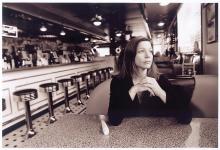
I’m inspired and troubled by the stories I have heard.
In the blue light of evening all boundaries get blurred.
And I believe in something better, and that love’s the final word,
And that there’s still something whole and sacred in the world.
—“Help in Hard Times,” by Carrie Newcomer
CARRIE NEWCOMER IS a Quaker singer-songwriter whose music is inspired by hope and the great human potential for peaceful coexistence. The Beautiful Not Yet is the title of both her newest album (Available Light Records) and an accompanying book of poems, essays, and lyrics. She is also working on a spoken word and music collaboration with Parker J. Palmer (author of Let Your Life Speak and Healing the Heart of Democracy) called “What We Need Is Here: Hope, Hard Times, and Human Possibility,” which is scheduled to premiere in spring 2017.
Newcomer lives in southern Indiana when she’s not traveling the world singing her folk and gospel-infused tunes and engaging social and environmental justice issues.
She was interviewed for Sojourners by John Malkin, a musician, journalist, and radio host in Santa Cruz, Calif., whose books include Sounds of Freedom: Musicians on Spirituality and Social Change and The Only Alternative: Christian Nonviolent Peacemakers in America.
John Malkin: When did you start making music?
Carrie Newcomer: I picked up a guitar when I was in my early teens and learned my first three chords and started writing songs. I’ve always loved the combination of language and music.
In the liner notes of The Beautiful Not Yet, you mention that many of these songs were written on trains and planes. How has travel been a part of your life and music?

I.
My family was earthquaked
I changed the noun into a verb
because it’s almost like someone did this to me on purpose ...
—Sanctuaries artist Mazaré, “Where is God in the Natural Disaster?”
OUTSIDE, A MID-NOVEMBER storm of biblical proportions is raging, but the hushed crowd gathered in this church basement is in rapt attention to a woman giving testimony. In the parking lot, a hollowed-out school bus holds the detritus of a homeless life. A handmade “Wheel of Misfortune” dangles from one rain-splattered window, over empty bottles and voided bank notes.
Suddenly the crowd erupts in cheers, and the poet, grinning, cedes the floor to a pair of musicians. Today the church is playing host to a collaboration between Street Sense, a publication run by and for Washington, D.C.’s homeless community, and The Sanctuaries, a D.C.-based art, spirituality, and justice collective. The bus—filled with real experiences of D.C.’s homeless community, represented by Sanctuaries artists—will tour the city as a mobile story. It’s the culmination of months of work. To some, it’s an act of resistance. To others, it’s church.
For all the breathless predictions of what the day after Nov. 8 might bring, a reckoning with mortality was not one of them. Yet a marked grief snaked across some newsfeeds and private emails in the days that followed—a feeling that with the election, something precious about life as we knew it had died.
That morning, the founding organizer of The Sanctuaries, Erik Martinez Resly, sent a simple note to members: “I love you.” A few improvised hours later, a small group had huddled at a church on 16th Street in D.C. to share the real-time experience of the country’s historic change in direction. For The Sanctuaries, response looked like art and togetherness—two qualities that have guided the group from its beginning.

A PERSON HAS a thousand ways of being, not just one but many selves, and Leonard Cohen embraced them all.
He sang the blues with Old World struggle, rasped epic tales and sometimes gospel, strumming Spanish chords on a broken-down guitar. But his final album, You Want It Darker, released a month after his 82nd birthday and only 17 days before he passed away, was like someone transcendently singing the prayer for ascension at his own funeral.
As if chanting a private liturgy, there was no more hunger for a voice. At last Cohen was the praise singer, aged and fatigued, a pilgrim with just one journey left to make. From the opening supplication—“I’m ready, my lord”—to the closing blessing—“It’s over now, the water and the wine”—the album is an uninterrupted prayer unto death.
“Traveling Light,” You Want It Darker’s ecstatic peak, bids au revoir to the self and the soul, the lover and beloved, the human and divine. Even in old age, Cohen is still no preacher, sage, or a saint. “I’m just a fool / A dreamer who / Forgot to dream / Of the me and you / I’m not alone / I’ve met a few / Traveling light / Like we used to do.”
Gone is the seductive blurring of sacred and profane and peeking through the curtain to glimpse the dealer’s latest game. The verses slide into an older and saltier way of singing, a sacred undertow, always there in songs of love and of despair, now amplified by the kind of wordless prayer people once sang from dusk until dawn.
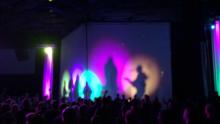
IT’S A WEDNESDAY night in early November and the sanctuary of Redemption Church in Olathe, Kan., is full. The audience, mostly 20- and 30-somethings, is listening in rapt attention to Mike McHargue, better known as Science Mike. Self-proclaimed science enthusiast McHargue, co-host (with musician and songwriter Michael Gungor) of The Liturgists Podcast, is doing a live episode of his solo side podcast, Ask Science Mike, as part of a tour for his new book, Finding God in the Waves.
After questions ranging from the neurological effect of belief on the brain to the role of women in the church, a young man stands and shares his story. He works at a conservative church, he says, and finds his beliefs are starting to differ from the people he works with. Finally, he asks, “When you start to ask big questions, and you don’t know where they’re going, and you don’t know where they’ll take you, how do you find the courage to continue to move forward when you know it might have dramatic consequences?”
“I have terrible news,” McHargue answers. “If this continues, you will not fit in where you are. How do I know? There are a thousand people at a Baptist church, who I love dearly, who could not stand to be in a room with me, because I’m the one who rebelled against the tribe.” He pauses a moment before continuing. “Here’s the other thing. This is good. The way you understood God, that served you for so long, isn’t working anymore because you’re growing. ... So I say, get excited.”
McHargue and his Liturgists Podcast co-host Gungor are no strangers to questions about belief, doubt, and straying from the theological tribe. Both men grew up in conservative evangelical churches, and both men lost their faith as adults, regaining it in a different form later on. It’s an experience familiar to plenty of the millennials and Gen-Xers who make up the “nones,” the growing portion of the U.S. population who have no religious affiliation.
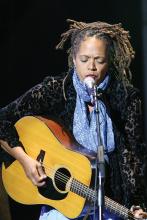
JUDITH CASSELBERRY'S ORIGINAL LOVE WAS MUSIC. She has been a guitarist and vocalist her entire adult life, including a 1980 to 1994 stint as part of the duo Casselberry-DuPreé. She now performs with Toshi Reagon and BIGLovely. She has shared the stage with Sweet Honey in the Rock, Odetta, Stevie Wonder, Etta James, and Elvis Costello, among others.
Along the way, while still performing, Casselberry earned her bachelor’s degree (in music production and engineering) and then, a few years later, a master’s in ethnomusicology, during which she discovered a passion for teaching. So she went to Yale, earning a doctorate in African-American studies and anthropology in 2008. She is an associate professor of Africana studies at Bowdoin College in Brunswick, Maine, teaching courses on African-American women’s religious lives, music and spirituality in popular culture, music and social movements, and issues in black intellectual thought.
Casselberry’s forthcoming book, The Labor of Faith: Gender and Power in Black Apostolic Pentecostalism (Duke University Press), employs feminist labor theories to examine the spiritual, material, social, and organizational work of women in a New York-based Pentecostal denomination, Church of Our Lord Jesus Christ of the Apostolic Faith (COOLJC). In the course of her research, Casselberry immersed herself for more than two years in the life of True Deliverance Church in Queens, N.Y. She spoke by phone with Sojourners senior associate editor Julie Polter in late January.
Sojourners: You examine the “religious work” of women—including prayer, teaching, care for the sick and grieving, liturgical music and movement, and guiding converts. Why did you choose this framework?

PRIOR TO THE ELECTION, I read J.D. Vance’s best-selling memoir, Hillbilly Elegy, in an attempt to understand Trump’s appeal to lower-income white Americans. However, this didn’t prepare me for the 81 percent of white evangelical Christians, some of them my extended family members, who cast their ballots for, it seemed to me, religious intolerance, misogynistic policies, environmental neglect, and white privilege. On Nov. 9, 2016, I awoke to find not just a world divided between Democrats and Republicans, but two versions of Christianity at odds with one another. Clearly, I had missed something.
Once initial shock over the election results subsided, I began purchasing books—stockpiling them. Perhaps I could build a wall of literature for protection, one of those enormous noise barriers separating residential neighborhoods from freeways, something to block out the racism and bigotry I assumed were behind the election results. What did theologians have to say about these topics? How had previous generations faced authoritarian threats? I searched progressive Christian reading lists: Howard Thurman’s Jesus and the Disinherited, Drew G.I. Hart’s Trouble I’ve Seen, Dietrich Bonhoeffer’s The Cost of Discipleship ... The list grew. I couldn’t stop. Amassing these titles and stacking them higher made me feel righteous. I began referring to them as my “resistance library.”
Existing titles from my bookshelves joined new acquisitions to form adjoining soundproof panels. Some portray a radically different God from the one with whom I grew up: Marcus J. Borg’s Meeting Jesus Again for the First Time, Walter Brueggemann’s The Prophetic Imagination, and Scott W. Gustafson’s Behind Good and Evil. Rachel Held Evans’s memoir, Faith Unraveled, details how she moved away from fundamentalism. Her faith journey mirrors parts of my own. After further rearranging within my bookcases, I erected another section dedicated to world religions. God Is Not One, Stephen Prothero’s book on eight world religions, sat next to Reza Aslan’s primer on Islam, No god but God, and the biography Mormon Enigma: Emma Hale Smith.

IN THE 2015 speech announcing his candidacy for president, Donald Trump declared, “The American dream is dead.” The people of Lancaster, Ohio, a small town at the edge of Appalachia, heard him loud and clear and later gave him 60 percent of their votes. Glass House: The 1% Economy and the Shattering of the All-American Town , by Lancaster native Brian Alexander, shows in fine-grained detail how the American dream of opportunity and fairness died in Lancaster and in similar towns all across the middle of the country.
Lancaster should have been the last place you would look for evidence of American decline. In 1947, a Forbes magazine cover story depicted it as “the All-American town.” It had a thriving manufacturing economy, a burgeoning middle-class, and enlightened civic leadership. For reasons of history and geography, Lancaster also had a reputation as “the whitest town in America,” but that didn’t bother Forbes too much back then.
The Lancaster of Alexander’s childhood and youth sounds a lot like Bedford Falls in the movie It’s a Wonderful Life, but as the 20th century wore on, the town turned into Pottersville. When Alexander went back to write this book, he found that the glass factory where his father had worked was demolished. Most people had to drive an hour or more to Columbus for a job, civic life was deteriorating, and opioid addiction was rampant.
The main foundation of Lancaster’s All-American past was Anchor Hocking, a Fortune 500 glass manufacturer. According to Alexander, the industrialists who built Anchor Hocking in the early 20th century were real George Bailey types. Sure, they wanted to make a buck, but they were suckers for fuzzy-headed notions about the common good that led them to subsidize various public amenities for the town and cooperate with the unions that delivered a family wage to generations of Lancastrians. In those days, we learn, executives and managers might live on the same block with machine operators and share beers at the same local tavern.
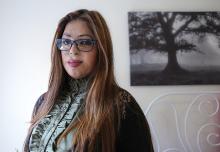
“I JUST TURNED 19 that April, the age a girl blossoms. I was attractive. I was a fashion student in Delhi. Two months later, driving my car in Lucknow, just like that, I was cooked, finished!”
Now 30, Monica Singh, throws back her head, with its reconstructed face, the product of 46 painful operations, and laughs with real gusto at this unseemly cosmic joke. I find myself, uneasily, laughing with her.
We are sitting in Gregory’s Coffee near Times Square in New York City. It is a January evening. The café is nearly empty, and the overhead lighting seems to be struggling to push back the darkness pressing in against the window. Singh is unfazed by this Hopperesque tableau.
In the weeks after her spurned suitor hired men to pour a bucket of acid over her, she was confined to a cage-like cubicle to protect her from infectious contact. “It was like being in a coffin,” she said. “People were looking at me from a distance. I felt like an animal in the zoo. But in my mind, I was already walking, going back to school, imagining that I didn’t open my car door to the men on the bicycle, that I didn’t leave the house that day.”

WE ALL HAVE a story of where we were that September morning, when the crumbling skyline of New York City brought the country to a standstill. For people on thousands of airplanes in flight that morning, their stories began with emergency landings and sitting for hours on the tarmac in unexpected places after U.S. airspace closed. Of those stranded “plane people,” 7,000 arrived in Gander, Newfoundland—an island town of about 10,000 locals and limited resources. The new Broadway musical “Come From Away” provides a snapshot of the rest of that story.
At a preview performance in February, the audience was on its feet for an ovation before the lights went down. For 100 minutes the musical allows the audience to pause and reflect on the events of Sept. 11. Claude Elliott, the mayor of Gander (played in the show by Joel Hatch), introduced the 10th-anniversary commemoration of 9/11 in Gander by saying, “We honor what was lost. But we also commemorate what we found.” To sit in the audience alongside New Yorkers with intimate connections to that day and tourists with their own reasons for being there was to pay tribute to those memories as part of a community of strangers.

THE ART OF ... book series from Graywolf Press focuses on writing craft and criticism. In each compact volume an accomplished writer takes on a single element or theme. The most recent entry in the series is The Art of Death, by Edwidge Danticat.
Danticat’s reflections on a wide variety of literature that wrestles with death—from Taiye Selasi’s debut novel, Ghana Must Go, to C.S. Lewis’ A Grief Observed—offer insights for readers as much as for writers. She explores the complicated emotional landscape of death and mourning, but also the myriad ways, tangled in questions of both justice and mercy, that death comes: accident, illness, deadly disasters, suicides, executions.
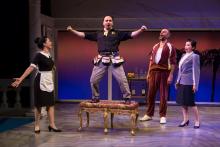
JUST AFTER DONALD TRUMP WAS ELECTED, Vice President Mike Pence went to see the hit Broadway musical “Hamilton,” prompting the cast to read a statement from the stage at curtain call stating that they were “alarmed and anxious” that the new administration would not protect the planet or a diverse citizenry.
This set off a Twitter war between Trump and opponents and posed the American theater community as an entity with a strong voice of dissent against Trump’s administration. POTUS-elect tweeted in reply to the cast’s statement that “the theater must always be a safe and special place” and then demanded that the cast apologize.
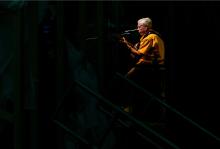
IF YOU WRESTLE WITH ANGELS, you will end up with a limp. When you struggle with God, engage the divine in lament-filled argument, cry out to the Creator for justice, hang on and refuse to let go without a blessing, you’ll end up with a posture bent over from the struggle and an uneven gait. Just watch Bruce Cockburn come onstage and you’ll see what I mean.
Known for hits such as “Wondering Where the Lions Are” (from the album Dancing in the Dragon’s Jaws), “Rocket Launcher,” and “Lovers in a Dangerous Time” (both from Stealing Fire), Cockburn’s evocative lyrics, exquisite guitar virtuosity, and unique blend of folk, jazz, and rock has brought him numerous awards and accolades over the years. More than 30 albums and close to a half century of touring would take its toll on anyone.
But there is more going on in the career of this Canadian singer-songwriter. The quiet Christian spirituality discerned in some of his early work was broken open in the 1980s when he first visited Central America. Revolutions and dirty wars in Nicaragua, El Salvador, and Guatemala opened his eyes to U.S. imperialism and the oppressive structures of global capitalism. Looking further abroad he became an advocate for ecological justice and the international banning of land mines. Closer to home Cockburn has railed against white nationalism married to the Religious Right while also passionately embracing the cause of Indigenous justice.
We haven’t heard much from Cockburn over the last few years. Writing his 2014 memoir, Rumours of Glory, took up so much creative energy that songwriting dried up for a while. But the muse returned, and the result is a new album, evocatively titled Bone on Bone: A reference on one level to the arthritis that afflicts Cockburn (though his guitar playing is still stunning), but perhaps more so to the wear and tear of a life of pilgrimage and a spirituality of resistance.

OPRAH WINFREY BEGAN HER acceptance speech for the Cecil B. DeMille Award at the 2018 Golden Globes by traveling through time. “In 1964, I was a little girl sitting on the linoleum floor of my mother’s house in Milwaukee. ... It is not lost on me that at this moment, there are some little girls watching as I become the first black woman to be given this same award.” Hours later, her speech dedicated to those enheartened children—particularly little black girls—was eclipsed by pleas for the entrepreneur to run for president.
Since the 2016 presidential election and, more recently, the Alabama Senate election, demand has been high for black women to save America from itself. The proposition’s allure appears only to increase when black women rebuff these requests to perform political labor as trouble intensifies. Jordan McDonald writes in Bitch magazine about this reprehensible exaltation—“Black women will save us”—and how it renders black women, from Oprah to Michelle Obama, indispensable saviors. “Stripped of our humanity and agency, the refrain does not ask that Black women save, but expects it of us, as if we each were God herself. It is a disturbing testament to the world’s continued failure to love us properly.” While this latest historical failure sought to conscript another black woman into a toolbox for the country’s deliverance, Oprah’s final message—“I want all the girls watching here, now, to know that a new day is on the horizon”—was impossible to rob.
As providence would have it, a film releasing this March has the potential to summon that new day, with none other than Oprah portraying the leader of a trio of immortal guides showing black girls universally what proper love looks like: the latest adaptation of Madeleine L’Engle’s 1963 Newbery Medal-winning classic novel, A Wrinkle in Time.

LAST YEAR WILL GO DOWN in history for many reasons. For women, it was the year we came together from all walks of life, said #MeToo—and were finally acknowledged and believed by many. There was and still is hope that this grassroots call for women’s rights and dignity will flow into all areas of life and become more than a symbolic action.
A glimpse of that future is taking form off-Broadway. This season three woman-written and -directed plays, performed by entirely female casts, opened to critical acclaim. It’s an exceedingly rare occurrence, as New York theater has endured a century of male dominance in all the related professions except costume design and stage management. In 2015, the League of Professional Theatre Women, as part of a project called Women Count, tracked the number of women working in all aspects of theater in 22 off-Broadway theaters from 2010 to 2015. Only 30 percent of plays premiering in these venues were written by women, with 33 percent being directed by women. So these multiple women-driven plays offer hope for gender equity in the theater world.
Redefining beauty
School Girls; Or, The African Mean Girls Play , by Jocelyn Bioh, is a dizzying romp through nasty coming-of-age teen dramedy that pays homage to Tina Fey’s classic Mean Girls. Taking place in a Ghanaian girl’s boarding school during the 1980s, Bioh’s first full-length play addresses cruel, clique-ish competition among adolescents using the template of the American genre, yet something fresh emerges. The story follows the queen of the school, Paulina (MaameYaa Boafo), as she vies to be named Miss Ghana and participate in the Miss Universe pageant.
While the comedic ending is not significantly surprising, there is a poignant and timely theme that emerges through the exploration of African beauty.
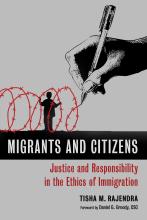
Tisha M. Rajendra discusses her new book, Migrants and Citizens: Justice and Responsibility in the Ethics of Immigration (Eerdmans), with Sojourners senior associate editor Julie Polter.